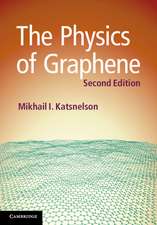Design and Fabrication of Large Polymer Constructions in Space
Autor Alexey Kondyurinen Limba Engleză Paperback – 5 oct 2022
The book begins by introducing the fundamentals and requirements of large constructions and inflatable structures for space. The next section of the book focuses on the utilization of polymeric materials within the space environment, examining the effects on materials (vacuum, plasma, temperature), the possible approaches to polymerization both in space and in orbit, the preparation and structure of polymer composites, and the methods for testing materials and structures in terms of strength, defects, and aging. Three chapters then cover how these materials and techniques might be applied to specific categories of construction, including larger space habitats, supporting space structures, and ground infrastructure. Finally, the financial aspects, the consequences for human space exploitation, and the possible future developments are discussed.
Using materials science to push the boundaries of construction for space exploration and exploitation, this book is a unique resource for academic researchers and advanced students across polymer science, advanced materials, chemical engineering, construction, and space engineering, as well as for researchers, scientists and engineers at space agencies, companies and laboratories, involved in developing materials or technology for use in space. This is also of great interest to anyone interested in the role of materials science in the building of large space stations, spacecraft, planetary bases, large aperture antenna, radiation and thermal shields, and repairmen sets.
- Describes the role of polymers in the construction of large space habitats, supporting space structures, and ground infrastructure
- Explains polymerization in the Earth’s orbit and in space, covering material specifications, control of curing, and the effects of interaction with the external environment
- Presents the possible testing methods, including strength evaluation, defect detection, and aging tests of materials and constructions
Preț: 1052.84 lei
Preț vechi: 1374.68 lei
-23% Nou
201.46€ • 219.52$ • 169.76£
Carte tipărită la comandă
Livrare economică 16-30 aprilie
Specificații
ISBN-10: 012816803X
Pagini: 630
Ilustrații: 200 illustrations (50 in full color)
Dimensiuni: 191 x 235 mm
Greutate: 1.07 kg
Editura: ELSEVIER SCIENCE
Public țintă
Academia: Researchers, graduate and postgraduate students in polymer science, polymerization, composites, advanced materials, polymer chemistry, chemical engineering, construction, space architecture, and aerospace engineering.Industry: Researchers, scientists and engineers developing materials, parts, technology or structures for space; space agencies, companies and laboratories involved in space technologyCuprins
1. Constructions in space
2. Inflatable structures
3. Materials in the space environment
4. Chemical curing in the space environment
5. Composite wall structure
6. Curing Process in Earth’s orbit
7. Evaluation of construction
8. Large space habitations
9. Supporting space structures
10. Ground infrastructure
11. Finance, investment, and future prospects
Descriere
Design and Fabrication of Large Polymer Constructions in Space is a ground-breaking study of the polymeric materials, advanced chemical processes, and cutting-edge technology required in the construction of large polymer-based structures for space, when all steps in the process are carried out in the space environment, whether in orbit, in deep space, or on the surface of a moon, asteroid, or planet.
The book begins by introducing the fundamentals and requirements of large constructions and inflatable structures for space. The next section of the book focuses on the utilization of polymeric materials within the space environment, examining the effects on materials (vacuum, plasma, temperature), the possible approaches to polymerization both in space and in orbit, the preparation and structure of polymer composites, and the methods for testing materials and structures in terms of strength, defects, and aging. Three chapters then cover how these materials and techniques might be applied to specific categories of construction, including larger space habitats, supporting space structures, and ground infrastructure. Finally, the financial aspects, the consequences for human space exploitation, and the possible future developments are discussed.
Using materials science to push the boundaries of construction for space exploration and exploitation, this book is a unique resource for academic researchers and advanced students across polymer science, advanced materials, chemical engineering, construction, and space engineering, as well as for researchers, scientists and engineers at space agencies, companies and laboratories, involved in developing materials or technology for use in space. This is also of great interest to anyone interested in the role of materials science in the building of large space stations, spacecraft, planetary bases, large aperture antenna, radiation and thermal shields, and repairmen sets.
- Describes the role of polymers in the construction of large space habitats, supporting space structures, and ground infrastructure
- Explains polymerization in the Earth’s orbit and in space, covering material specifications, control of curing, and the effects of interaction with the external environment
- Presents the possible testing methods, including strength evaluation, defect detection, and aging tests of materials and constructions

















